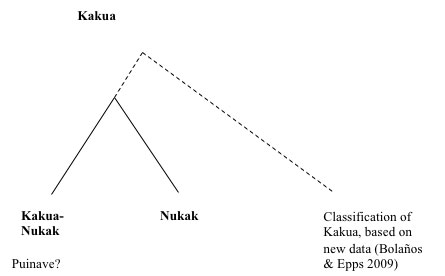Project Members
- Katherine Bolaños
A Grammar of Kakua: A Language of Northwest Amazonia
Kakua is a language spoken in northwestern Amazonia, in the Vaupés region of eastern Colombia, between the Vaupés and Papurí Rivers. It is spoken by less than 200 people with a strong hunter-gatherer orientation.
Nearly all Kakua use Kakua as their main language. Because of rapid socio-economic change, and the small total number of Kakua speakers the vitality of the language could easily change drastically in the near future.
This project aimed to produce a reference grammar of Kakua, including detailed descriptions and glossed corpus of a variety of genres.
Kakua represents a language family that is itself very poorly understood. Until recently Kakua was grouped into a so called “Maku” family, a cultural rather than linguistic classification. Current data suggests that Kakua is related to Nukak, but not to other “Maku” (Nadahup, Epps 2008) languages (Bolaños & Epps 2009).

Classification of Kakua, based on new data (Bolaños & Epps 2009)
The relationship of Kakua and Puinave (spoken to the northeast, outside of the Vaupés area, in the Colombian department of Guainía), is still uncertain. Comparison of 1,800 lexical between Kakua and Puinave revealed a number of potentially cognate forms and a few potentially regular sound changes, all with many exceptions. These may reflect either a common ancestor, or ancient contact between these groups.